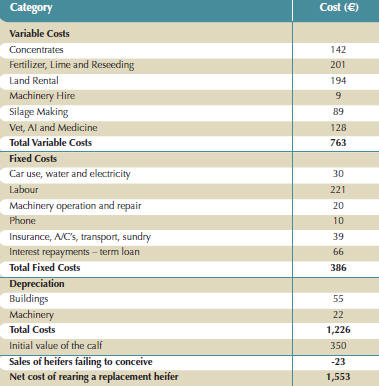



Contract Rearing Replacement Heifers
Rearing heifers off-farm will free up time and labour allowing farmers to focus on dairying at home, however there is a risk of diseases. For rearers it allows extra income and a challenging new enterprise.When should off-farm heifer rearing be considered?
- Where overall farm profit can be increased by carrying a greater number of cows;
- Farms where labour is a limiting constraint;
- Farms where land is a limiting constraint;
- Farms where replacement heifers are failing to reach the target liveweights;
- Farms where separation of cows from replacement heifers (even calves) is required for disease control purposes, e.g. Johne’s Disease.
- It can provide a means of using land and buildings without investing in stock – reducing the risk involved;
- It can often be possible to run the enterprise on a part-time basis;
- The need to buy and sell stock is reduced;
- Cash flow can be improved because the ‘norm’ is the rearer is paid by direct debit on a monthly basis;
- The business may return a higher profit than the rearer’s existing enterprise.
| Table 1: Target weights (kg) for heifers at different stages during 24 month rearing period | ||||||||
|---|---|---|---|---|---|---|---|---|
| Age | % Mature liveweight | Holstein Friesian | New Zealand/ British Friesian | Jersey X Holstein Friesian | ||||
| Birth | - | 38 | 36 | 34 | ||||
| 6 weeks | - | 63 | 60 | 56 | ||||
| 3 months | - | 90 | 85 | 80 | ||||
| 6 months | 30% | 155 | 148 | 138 | ||||
| 12 months | - | 280 | 267 | 250 | ||||
| 15 months | 60% | 330 | 315 | 295 | ||||
| 21 months | - | 490 | 470 | 437 | ||||
| 24 months | 90% | 550 | 525 | 490 | ||||
Recommended liveweight targets
Every heifer rearing programme should have a target live-weight and specified age at first-calving. Previous research indicates that heifers should be mated at 60 per cent of mature live-weight and should calve at 90 per cent of mature live-weight. However, recommended mature live weights vary considerably between breeds and crossbreeds. The data in Table 1 shows recommended target weights (kg) for some breeds.
Guideline Costs
Table 2 shows the guideline costs associated with replacement heifer rearing. These costs are based on Moorepark farm for the EBI system and will vary considerable from farm to farm.

The guideline net cost of rearing a replacement is €1,553 per head. When contract rearing replacement heifers, the rearer will incur both variable and fixed costs. Typically, calves will move to the rearer’s farm at three months of age and will return home at 22 months of age. They will return home in early December of the following year. The data in Table 3 is based on these assumptions. It indicates the guideline level of cost that may be incurred on the rearer’s farm for a February born heifer. It excludes the costs incurred prior to the arrival on the rearer’s farm (at three months of age) and those incurred after the heifers return home to the dairy farmer’s own herd (at 22 months of age).
Teagasc say that the cost of rearing replacements will vary considerable from farm to farm as some rearers may feed more concentrates than others, additional silage may be required at the start of the second winter and some farmers may feed crops that may reduce costs. Teagasc have estimated that the variable and fixed costs of rearing a spring born heifer is €1.18 per day with an average daily gain of 0.7 kg.
Table 3 shows the estimated return to a beef farmer for replacement heifer rearing assuming €15 per hour and a time of 12 hours per heifer for the 19 month period. This will obviously vary from farm to farm as some may be more labour efficient than others. The costs are based on €1.18 per day per heifer.
| Fee (€/heifer/day) | €0.90 | €1.00 | €1.10 | €1.20 | ||||
| Stocking rate (heifer unit/ha) | 2 | 3 | 2 | 3 | 2 | 3 | 2 | 3 |
| Receipts (€/ha) | 1,042 | 1,563 | 1,158 | 1,737 | 1,274 | 1,911 | 1,390 | 2,084 |
| Costs excl. labour (€/ha) | 1,008 | 1,512 | 1,008 | 1,512 | 1,008 | 1,512 | 1,008 | 1,512 |
| Margin for labour (€/ha) | 34 | 51 | 150 | 225 | 266 | 399 | 382 | 572 |
The above table shows that the margin obtained per hectare for labour varies considerable with the daily fee paid and with the stocking rate. At low milk prices, dairy farmers will be especially sensitive to the fees charged for off-farm rearing of replacement heifers.
What are the risks for both when engaging in off-farm heifer rearing?
- Loss of control in the day-to-day management of the replacement heifers.
-
The risk of a disease outbreak. With animals on two farms, the risk of either group contracting diseases such as TB, eptospirosis etc. is doubled. If the rearer is simultaneously taking heifers from other owners or has another livestock enterprise the risks may be further multiplied. Contingency plans must be put in place to ensure that an outbreak of disease does not have implications for the smooth return of the heifers to the dairy farm at the end of the rearing period or result in calving heifers ‘stuck’ with a rearer with no facilities to calve or milk such animals.
-
Possibly poorer replacement heifers. Not all rearers will be suitably skilled to achieve the target weights set down for replacement heifers. It is very useful to weigh heifers at defined times throughout the rearing process (e.g., before the first winter; pre-breeding and before the second winter) to ensure that the appropriate targets are achieved. A plan should be put in place in advance of entering the contract to address the issue where targets are not reached e.g., through concentrate supplementation over winter.
- Risk of conflict between the owner and rearer. In all cases, clear targets must be agreed by both parties in advance of entering the contract arrangement. In addition, an independent arbitrator should be agreed in advance in the event of a conflict occurring between the owner and rearer.
Disease control guidelines
Diseases associated with replacement heifers are regulatory diseases such as TB and brucellosis and non-regulatory diseases such as BVD, bacterial diseases, Johne's.
It is important to have a biosecurity plan in place, off-farm heifer rearing will make a closed herd impossible. However it is still possible to reduce the risk of disease by knowing the current disease status of the rearer's herd, viewing heifers previously reared on the farm, ensure there are stock proof boundaries between the rearer's farm and neighbouring farms and implement a strategic vaccination protocol for heifers based on the disease status of the farm.
A pre-movement test should take place when cows are 22 months old, they should be returned to the owner's farm at least six weeks before calving.
What to put in the contract?
Contracts will allow for day-to-day issues that arise to be identified, discussed and agreed upon. The contract should include things such as ownership status of the animals, agreed costs, dates of arrival/ planned removal, agreed final and intermediate weights, health programmes, if heifers will be mixing with other stock and breeding programme.
It should also address mortality (who covers the cost, is the rearer paid or rearing costs refunded?), who pays for transport, method of payment, what happens to barren heifers, what will they be fed - quality of feed etc.
Before entering into a contract the owner should visit the rearer's farm to see quality of grassland, look over existing stock, check boundary fencing and quality of housing. In return, the rearer should visit the owner's farm to check standard of farming there.
October 2009


